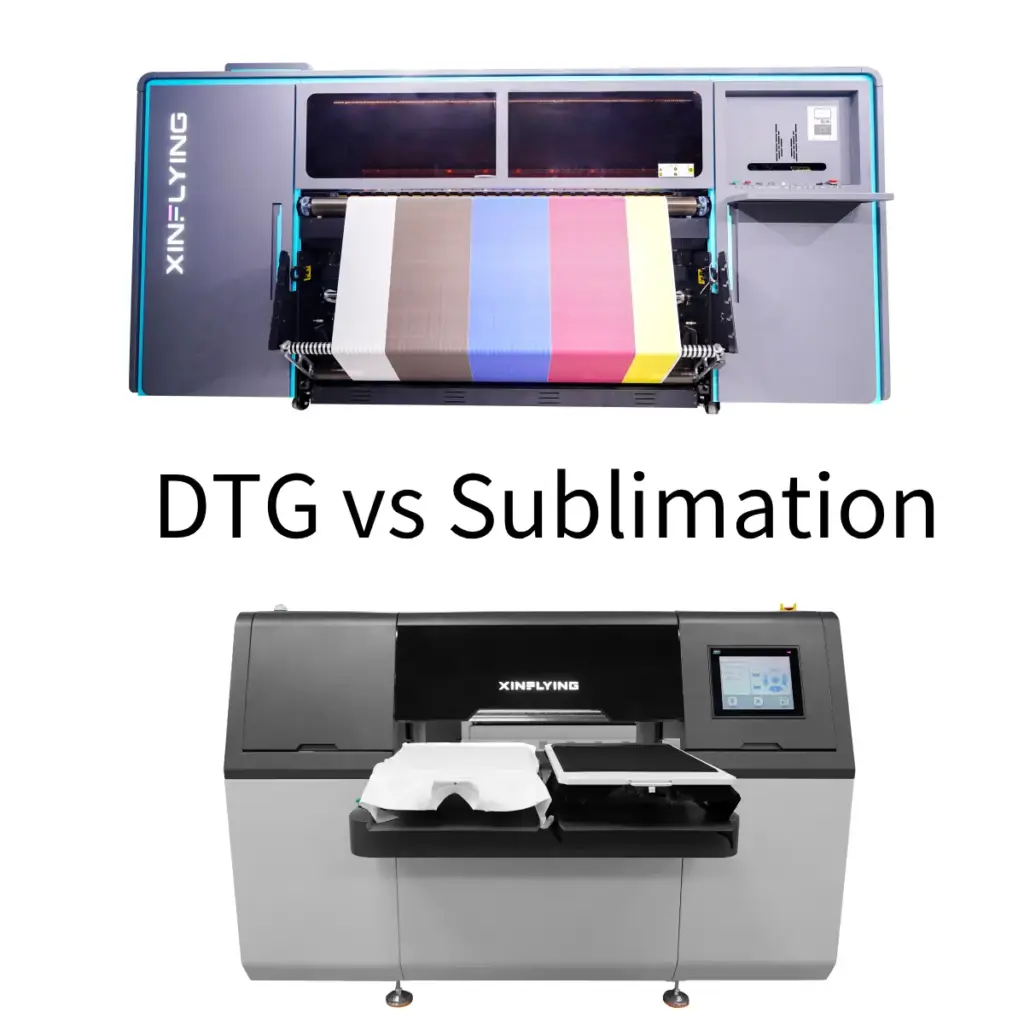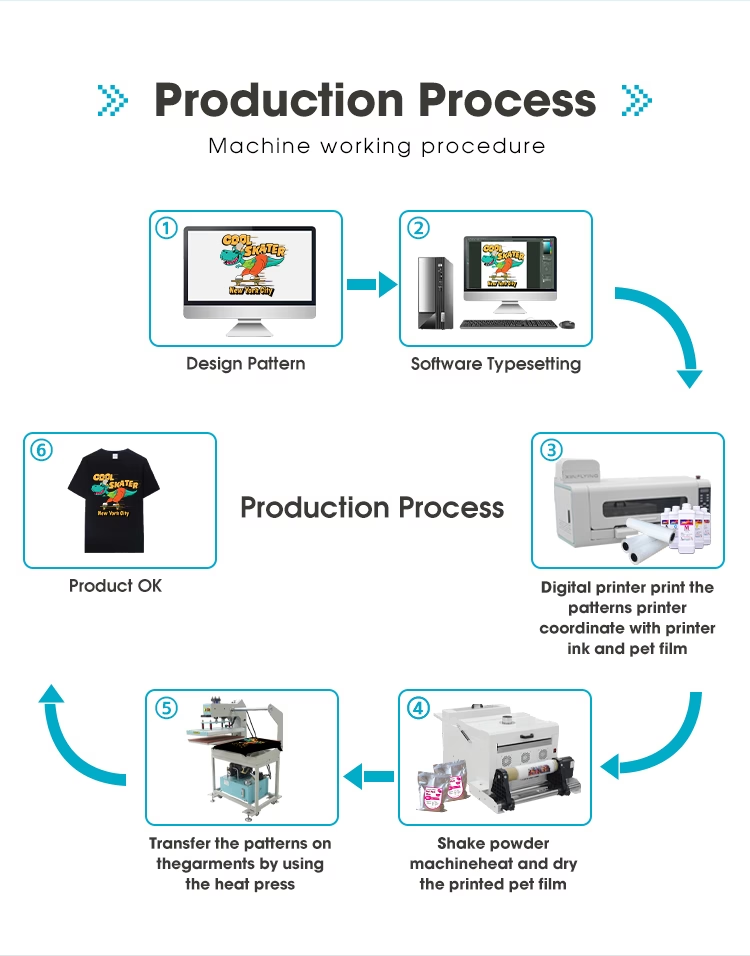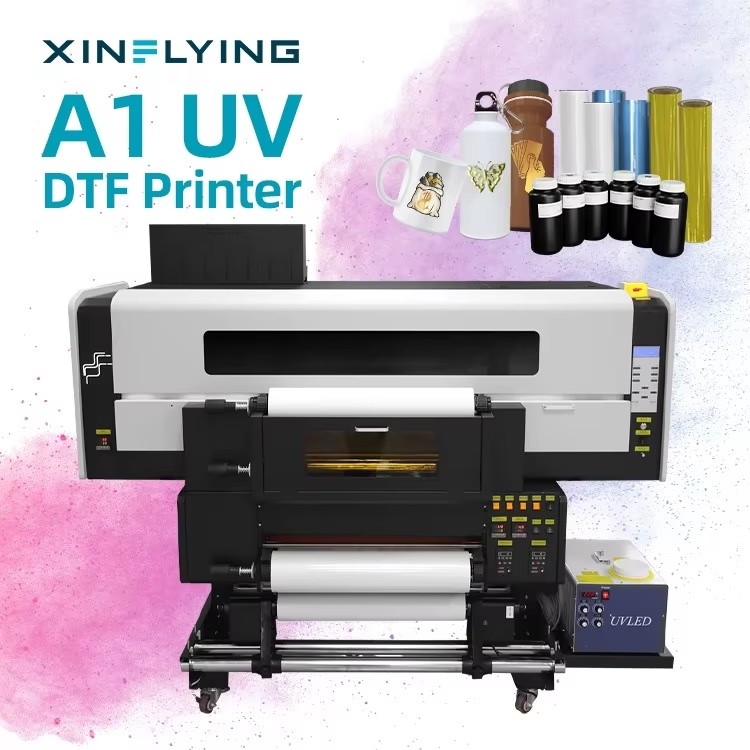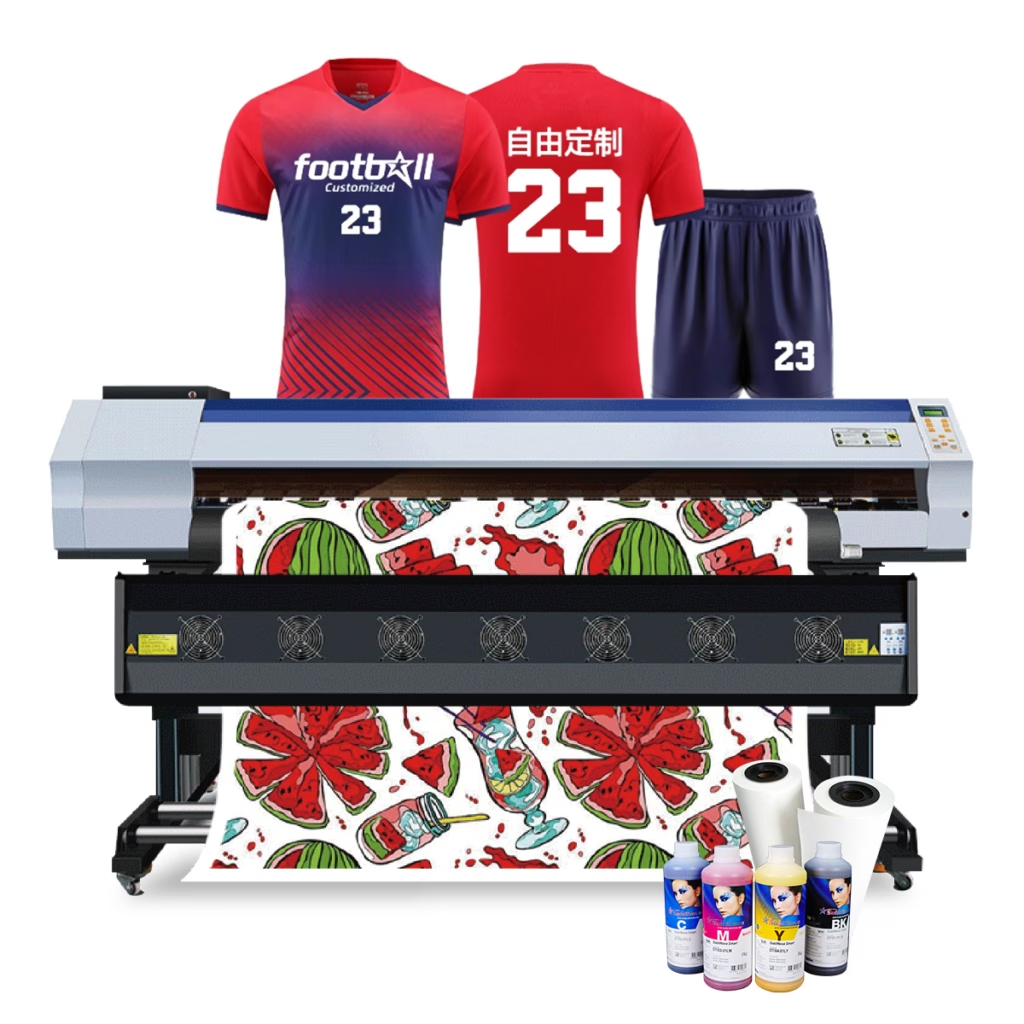Percetakan DTF UV adalah teknologi canggih yang merevolusikan industri percetakan digital. Ia menawarkan cetakan berkualiti tinggi dengan warna yang bersemangat dan terperinci yang luar biasa, menjadikannya pilihan yang popular untuk pelbagai aplikasi. Dalam panduan ini, Kami akan meneroka asas percetakan UV DTF, kebaikan dan keburukannya, peralatan yang diperlukan, dan proses langkah demi langkah. Selain itu, Kami akan menyelidiki beberapa petua dan amalan terbaik untuk mencapai hasil yang optimum dan membincangkan pelbagai aplikasi untuk percetakan UV DTF
Apakah itu Percetakan DTF UV

Percetakan DTF UV, juga dikenali sebagai percetakan langsung ke filem UV, adalah teknik percetakan digital yang Menggunakan dakwat yang boleh disembuhkan UV untuk mencetak reka bentuk langsung ke filem pemindahan khusus. Filem ini, dilapisi dengan lapisan pelepasan, membolehkan reka bentuk mudah dipindahkan ke pelbagai bahan, termasuk tekstil, kayu, kaca, dan logam.
Apa yang Menetapkan Percetakan DTF UV Selain Kaedah Percetakan Tradisional adalah keupayaannya untuk menghasilkan cetakan dengan terperinci yang luar biasa dan warna yang bersemangat. Tidak seperti kaedah lain yang menggunakan lapisan dakwat di atas bahan, Percetakan DTF UV menembusi permukaan, menghasilkan cetakan yang lebih tahan lama dan tahan lama. Dakwat yang boleh disembuhkan UV yang digunakan dalam proses ini menyembuhkan dengan serta -merta apabila terdedah kepada cahaya ultraviolet, Membuat ikatan yang kuat dengan substrat.
Uv dtf vs dtf


Perbezaan utama antara uv dtf dan dtf (Terus-ke-Filem) Percetakan terletak di proses dakwat dan pengawetan digunakan.
Dalam Percetakan DTF UV, Dakwat yang boleh disembuhkan UV digunakan, yang menyembuhkan dengan serta -merta apabila terdedah kepada cahaya ultraviolet. Proses pengawetan ini memberikan ketahanan yang sangat baik, warna-warna terang, dan penentangan terhadap pudar dan lelasan. Percetakan DTF UV membolehkan percetakan pada pelbagai bahan dan menawarkan masa pengeluaran yang lebih cepat berbanding dengan DTF.
Sebaliknya, percetakan DTF Menggunakan dakwat berasaskan air yang memerlukan haba dan tekanan untuk pemindahan. Reka bentuk dicetak ke filem, yang kemudiannya dipindahkan ke substrat. Percetakan DTF juga memberikan warna yang bersemangat tetapi mungkin tidak menawarkan tahap ketahanan yang sama seperti cetakan UV DTF.
Keseluruhannya, Percetakan DTF UV menawarkan ketahanan yang lebih tinggi dan masa pengeluaran yang lebih cepat, Walaupun percetakan DTF boleh menjadi pilihan kos efektif untuk operasi berskala kecil. Pilihan antara keduanya bergantung pada faktor seperti kualiti cetakan yang dikehendaki, Keperluan ketahanan, dan pertimbangan belanjawan.
Kelebihan dan keburukan percetakan UV DTF

Kelebihan Percetakan DTF UV
- Warna cetak tinggi dan warna bersemangat: Percetakan DTF UV menawarkan kualiti cetakan yang luar biasa dengan butiran segar dan warna yang bersemangat. Dakwat yang boleh disembuhkan UV yang digunakan dalam proses ini mempunyai gamut warna yang lebih luas, membenarkan pembiakan warna yang tepat.
- Fleksibiliti dalam mencetak pada pelbagai bahan: Percetakan DTF UV boleh digunakan untuk pelbagai bahan, termasuk fabrik, plastik, seramik, dan logam. Ini adalah teknik percetakan yang serba boleh yang membuka kemungkinan yang tidak berkesudahan untuk penyesuaian.
- Masa pengeluaran yang lebih cepat berbanding dengan kaedah lain: Percetakan DTF UV terkenal dengan masa pengeluarannya yang pantas. Dakwat yang boleh disembuhkan UV kering serta -merta apabila terdedah kepada cahaya ultraviolet, menghapuskan keperluan untuk mengeringkan masa dan membenarkan pemulihan cepat.
Kekurangan Percetakan DTF UV
- Faktor kos dan pelaburan awal: Percetakan DTF UV memerlukan peralatan khusus, termasuk pencetak DTF UV, Dakwat yang boleh disembuhkan, dan salutan. Pelaburan awal boleh tinggi, menjadikannya kurang dapat diakses untuk perniagaan berskala kecil.
- Batasan dalam mencetak butiran dan kecerunan yang baik: Sementara percetakan UV DTF menawarkan perincian yang luar biasa, Ia mungkin mempunyai batasan ketika mencetak butiran dan kecerunan yang baik. Ketebalan dakwat yang dapat disembuhkan UV dapat mempengaruhi kelancaran kecerunan, Memerlukan teknik tambahan untuk mencapai hasil yang diinginkan.
- Memerlukan peralatan dan kepakaran khusus: Mengendalikan pencetak DTF UV memerlukan pengetahuan dan kepakaran khusus. Penyelenggaraan dan penentukuran yang betul adalah penting untuk kualiti cetakan yang konsisten. Selain itu, Memahami perisian RIP dan pengurusan warna sangat penting untuk mencapai pembiakan warna yang tepat.
Apa yang saya perlukan untuk Percetakan DTF UV
Untuk memulakan perjalanan percetakan UV DTF anda, anda memerlukan peralatan dan bahan berikut:
Pencetak UV DTF
Pencetak khusus ini direka untuk mengendalikan dakwat yang boleh disembuhkan UV yang digunakan dalam proses percetakan DTF. Ia dilengkapi dengan ciri canggih untuk percetakan yang tepat dan pengawetan UV.
Dakwat dan lapisan yang boleh disembuhkan UV
Dakwat yang boleh disembuhkan UV secara khusus dirumuskan untuk menyembuhkan dengan serta -merta apabila terdedah kepada cahaya ultraviolet. Dakwat ini menawarkan warna cerah dan lekatan yang sangat baik kepada pelbagai substrat. Lapisan UV digunakan untuk meningkatkan ketahanan dan penamat cetakan.
Filem pemindahan dan kertas pelepasan UV DTF
Filem pemindahan DTF UV bertindak sebagai pembawa reka bentuk semasa proses percetakan. Ia dilapisi dengan lapisan pelepasan yang membolehkan pemindahan reka bentuk mudah ke substrat yang dikehendaki. Kertas Siaran digunakan untuk melindungi filem pemindahan UV DTF yang dicetak semasa penyimpanan dan pengangkutan.
Laminator
Mesin laminating digunakan untuk memindahkan reka bentuk bercetak dari filem pemindahan DTF UV ke substrat yang dikehendaki. Ia memastikan lekatan yang betul dan menghapuskan gelembung udara, mengakibatkan pemindahan lancar.
Proses langkah demi langkah Percetakan DTF UV
- Reka bentuk dengan perisian RIP di komputer dan letakkan bahagian pelekat filem UV DTF di platform pencetak UV DTF.
- Praisi kartrij dengan dakwat CMYK, dakwat putih, dan varnis untuk mencetak reka bentuk anda pada filem UV DTF.
- Gunakan mesin laminating bersama dengan pencetak DTF UV untuk memindahkan corak pada filem B.
- Kupas filem corak dan lekatkannya pada item yang ingin anda cetak. Kemudian perlahan -lahan mengupas filem B, dan produk anda sudah siap.
Petua dan amalan terbaik untuk percetakan UV DTF

Untuk memastikan hasil yang terbaik dan mengoptimumkan pengalaman percetakan UV DTF anda, Pertimbangkan untuk melaksanakan petua dan amalan terbaik berikut:
Memilih substrat yang sesuai untuk hasil yang optimum
Memilih substrat yang sesuai adalah penting untuk mencapai kualiti cetakan yang optimum. Bahan yang berbeza mempunyai sifat permukaan yang berbeza dan keserasian dengan percetakan UV DTF. Eksperimen dengan pelbagai substrat untuk mencari yang menghasilkan hasil terbaik untuk reka bentuk khusus anda. Pertimbangkan faktor seperti tekstur, penyerapan, dan warna untuk memastikan hasil yang diinginkan.
Penyelenggaraan dan penjagaan yang betul bagi pencetak DTF UV
Penyelenggaraan dan penjagaan yang tetap sangat penting untuk umur panjang dan prestasi pencetak DTF anda. Ikuti Pengilang pencetak kainGaris panduan untuk prosedur pembersihan, penyelenggaraan pencegahan, dan penentukuran. Simpan pencetak dalam persekitaran yang bersih dan bebas debu untuk mengelakkan sebarang pencemaran yang boleh menjejaskan kualiti cetak.
Menguji dan bereksperimen dengan tetapan dan teknik yang berbeza
Percetakan DTF UV menawarkan pelbagai pilihan dan kesan penyesuaian. Luangkan masa untuk bereksperimen dengan tetapan yang berbeza, seperti kepadatan dakwat, mengubati masa, dan resolusi cetak. Uji pelbagai teknik untuk mencapai kemasan yang dikehendaki, kecerunan, dan tekstur. Simpan rekod tetapan dan hasil anda untuk rujukan masa depan.
Pilihan pemprosesan dan penamat untuk ketahanan yang dipertingkatkan
Pertimbangkan pilihan pemprosesan dan penamat untuk meningkatkan ketahanan dan estetika cetakan UV DTF anda. Memohon lapisan pelindung atau varnis dapat meningkatkan ketahanan terhadap lelasan, UV pudar, dan pendedahan kimia. Bergantung pada substrat, Anda juga boleh meneroka teknik tambahan seperti menekan haba atau menyulam untuk menambah dimensi dan tekstur ke cetakan anda.
Mengoptimumkan perisian rip dan pengurusan warna
Perisian RIP memainkan peranan penting dalam pengurusan warna dan ketepatan cetak. Pastikan perisian RIP anda dikalibrasi dan profil disediakan dengan betul. Gunakan swatch warna dan spektrofotometer untuk mengesahkan ketepatan dan konsistensi warna. Kerap mengemas kini perisian anda untuk mendapat manfaat daripada ciri dan penambahbaikan terkini.
Permohonan percetakan DTF UV

Percetakan DTF UV mendapati aplikasi dalam pelbagai industri kerana hasil fleksibiliti dan berkualiti tinggi. Beberapa aplikasi biasa merangkumi:
- Industri pakaian dan pakaian: Percetakan DTF UV digunakan secara meluas untuk mencetak pada t-shirt, hoodie, dan barang kain lain. Ia menawarkan keupayaan untuk mencetak reka bentuk bersemangat dengan perincian yang luar biasa, menjadikannya pilihan yang popular untuk penyesuaian.
- Hiasan rumah dan pemperibadian: Dalam industri hiasan rumah, Percetakan DTF UV membolehkan menyesuaikan tekstil rumah, kusyen, dan cetakan kanvas. Ia menawarkan kemungkinan yang tidak berkesudahan untuk reka bentuk yang diperibadikan dan mencipta barang hiasan yang unik.
- Bahan promosi dan pemasaran: Percetakan DTF UV adalah pilihan yang sangat baik untuk membuat sepanduk yang menarik, poster, dan barangan promosi. Warna yang bersemangat dan kualiti cetak yang tinggi menjadikan reka bentuk menonjol, meninggalkan kesan abadi terhadap pelanggan yang berpotensi.
- Aplikasi perindustrian dan komersial: Percetakan DTF UV boleh digunakan pada bahan tegar seperti kayu, kaca, dan logam. Ia membuka peluang untuk penyesuaian dalam sektor perindustrian dan komersial, termasuk papan tanda, pelabelan, dan hiasan produk.
Kesimpulan
Percetakan DTF UV adalah penukar permainan dalam industri percetakan digital, Menawarkan cetakan berkualiti tinggi dengan warna yang bersemangat dan terperinci yang luar biasa. Kepelbagaiannya dalam mencetak pada pelbagai bahan, Digabungkan dengan masa pengeluaran yang lebih cepat, menjadikannya pilihan yang menarik untuk perniagaan dan individu. Dengan peralatan yang betul, bahan, dan kepakaran, Percetakan DTF UV membentangkan peluang yang tidak berkesudahan untuk penyesuaian dan kreativiti. Merangkul teknologi ini dan meneroka potensi tanpa batas yang dipegangnya dalam dunia percetakan digital.







